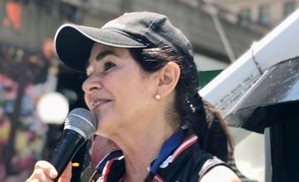By Brent Hoffmann, 2005
When did you first put on a mask? Most of us began masking in March 2020, because of Covid. Edie Scala-Hampson began masking in 1988, because it was part of her job. She’s a docent who works as a certified industrial hygienist and certified hazardous materials manager. “My first N95 mask was worn when I had to conduct air sampling at a lead paint pigment manufacturing facility in Indiana,” said Edie. “The Occupational Safety Administration requires workplaces to be free of recognized hazards. And personal protective equipment (PPE) is a last resort after elimination, substitution, engineering controls, and administrative controls can’t control the hazards. We all well know by now, wearing masks and PPE can be burdensome when we have to do a physical job for eight hours a day.

“When I was a girl, I had a knack for science,” she continued. “So, I majored in biology with a minor in chemistry at Loyola University in Chicago. And for the past 11 years, I’ve worked for HydoGeoLogic Inc., an environmental engineering firm based in Reston, Virginia. I provide technical expertise for toxic wastes at Environmental Protection Agency superfund sites and U.S. military bases. My job involves determining chemical exposure monitoring, chemical emergency response, PPE, risk management, toxicology support, and management of the company’s biological marker medical surveillance program and occupational safety and health regulatory compliance.
Nuclear Cleanup
“The environments we clean up,” Edie explained, “include those contaminated with metals, pesticides, chlorinated solvents, hydrocarbons, chemical warfare materiel, unexploded bombs and mines, as well as contaminants associated with firefighting foam. We’re even equipped to deal with residual radiological hazards dating back to World War II, such as the U.S. Manhattan Project that produced the first nuclear weapons.
“I’m now involved in a cleanup at the Army’s Aberdeen Proving Ground in Virginia. While buildings are being demolished, we check for nerve agents, highly flammable white phosphorus, and other contaminants. It’s a job that often calls on all personnel to wear an aluminum hazmat suit.”
Block 37
Locally, one of Edie’s first assignments — after she’d set up her own industrial hygiene consultancy, ESH Services –- involved the cleanup of Bock 37 in the Loop. “It was like a mining operation,” she said. “We monitored workers and checked for air quality to make sure there weren’t excessive byproducts of combustion during the earthmoving operations.”
Edie monitored contamination at Lindsay Light, near the Spire construction site in Streeterville. “Lindsay made gas mantles such as those used in Coleman lanterns. In 1993, the EPA found thorium contamination in the soil at several Streeterville locations.” She also worked in Chicago’s freight tunnels to remediate chemical spills.

The Blue Bonneville
“My interest in architecture started in my husband’s vintage car, a Pontiac Bonneville convertible we affectionately called the ‘blue car’,” said Edie. “Our family used to give tours in the convertible for out-of-town friends. We’d drive down Lake Shore Drive, then up Michigan Avenue to show off the Tribune and Wrigley buildings. The car drove like a big boat. My husband would narrate, since he was a broadcast reporter with the Associated Press and knew the downtown much better than me. Eventually, I traded in the Bonneville and became a docent in 2009. I traded my car for the First Lady riverboats so I could continue to give tours and honor the memory of my late husband.” In addition to leading our river architecture tours, Edie is certified for the new Hotel Boom tours.
“Having once worked for a structural engineering firm, I like to add information about buildings’ structures,” explained Edie. “How they stand up on caissons, columns or piers drilled deep into the earth’s hardpan or bedrock. For example, if I have time, I’ll mention the automated caisson system at the Wyndham, the hotel in the Dark Knight movie — and the timber construction of the Fulton Cold Storage building on the north branch.”
When Unmasked
Until Covid intervened, Edie volunteered at Gilda’s club, a cancer wellness center in Chicago. “I did cooking demonstrations with chefs from city restaurants,” she added. “I like to cook, and miss having people over for dinner.”
She enjoys architecture travel. In 2019, Edie did a four-day hike with a friend to Machu Picchu, the Inca ruins in Peru. “I was in Barcelona, Spain, in 2020,” she said. “I wanted to see Antoni Gaudi’s work, including the Sagrada Familia church and his Casa Mila-La Pedrera apartment buildings. Like CAC docents, the tour guides were knowledgeable, and I learned things I’d never known without their insights.”
_____________________________________________________________________________________

PHOTOS:
- Edie (left) wears a Tyvek hazmat suit and full-face respirator, preparatory to cleaning up an EPA superfund site in Delaware.


Thank you for this very interesting profile of Edie.!
Thanks for another fascinating, well-written profile!
Who knew?!?! Such an interesting background, Edie. Thanks, Brent.
I never knew that Edie was involved in this kind of work. We sure have a docent body with lots of different kinds of expertise! Thanks, Brent for writing this, and Edie for sharing your fascinating story.
Very interesting! (We should do a docent version of What’s My LIne? someday, maybe at a future DAN.)
Always fun to learn now about a docent colleague. And I love the picture of Edie in her hazmat gear!
Thanks Brent for the enlightening us with this profile of Edie, whom I got to know while she was on Tour Committee. Edie was always very pleasant, and as you note, often related details of her unusual travel experiences ( both for work and for pleasure). Hope to see you in the near future..
Thanks for sharing this interesting life story!